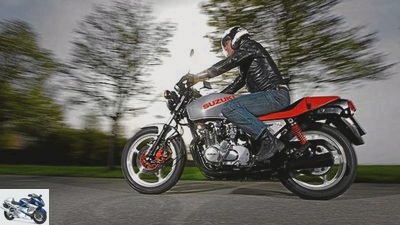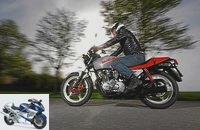Menus

Photos:
Final Suzuki GS 550 Katana
A late acquaintance
30 years ago Suzuki presented the Katana series. However, it was not the spectacularly styled 750s and 1100s that fascinated the author at the time, but the well-proportioned 550s and 650s. High time to make their acquaintance.
At the end of the 1970s there were about 20 people in our clique who came together in a growing enthusiasm for motorcycles. We orientated ourselves towards older classmates; a few of us also had older brothers. They thundered with their Harleys, Laverdas or single-cylinder Ducatis in front of school and in the evenings in front of the most important pub in the world that we felt pretty harmless.
Like our mokicks. Green boys, we were deeply impressed when we saw how "Beesa"-(BSA) driver Frank plucked a Kawasaki patch from the leather jacket of the newly minted Guzzi California owner Jorg. Only then was he allowed to kick his own Cali. We learned that Sausel four-cylinder from the Far East are contemptible devices; the only respected Japanese motorcycle was the Yamaha XT 500. MV Agusta and Munch, as European four-cylinder motorcycles, did not whisper, but grinded and roared. For a long time we didn’t want to understand that they didn’t go and didn’t stop.
KI have an idea why I found the double-cam engines from Suzuki, whether as a two-cylinder 400 or as a four-cylinder with 550, 750 and 1000 cc displacement, so captivatingly beautiful despite this one-sided imprint, oh what, this veneer. But I would have rather bitten off my tongue than admitted this irritating fascination. I wasn’t confident enough for that back then. Why am I telling this? Because she attacked me again the other day when Thomas was doing a major inspection on his Katana 550. Thomas was once my neighbor, is now my friend and has been looking after Suzi just as carefully as his two younger motorcycles for 28 years. The Katana, which took over the engine of the GS 550 E from 1977, has almost 25,000 kilometers on the clock, is unrestored in the original paint and would even be an ornament for the Suzuki factory museum. He gave it to me for this story, which is a belated commitment to the Suzuki four-cylinder at the time and the design of the little katana. It was less spectacular than the 750 and 1100, but simply more beautiful in my eyes.
Buy complete article

Final Suzuki GS 550 Katana
A late acquaintance
Despite its 222 kilos, the katana swings easily through the late afternoon.
The 550 runs cultivated up to 7000 rpm, with occasional slight hiccups during load changes. In addition, it unfolds a downright splendid mood, turns willingly and with a tingling roar up to 10,000 rpm and even beyond. I’m sorry, Thomas, but that’s how he wanted it.
The first impression is confirmed: There is a lot going on in this engine and, unlike the slide-bearing modern engines, the Suzuki veteran shares this freely. Even taking off the accelerator becomes a sensual experience of mechanical friction. The four-cylinder seems to generate a great deal of this internally; it brakes the 222-kilogram motorcycle vigorously just by closing the flaps. Despite the huge single-piston floating calipers, the double disc at the front can only do that a little better. According to contemporary tests, the effect and controllability suffer from the branching off of the brake lines to the anti-dive, which is supposed to prevent the fork from dipping quickly when braking, but whose function is not particularly important. Say the least. Is it because of the jeans I wear with the contemporary Harro racing vest, or is the now completely warmed-up engine actually spreading a beefy heat? He does it, and as I drive slowly through the villages, vapors of hot, slightly oil-laden air rise up on me. After putting it down, the chunk cools down again with audible crackling and crackling. It slowly dawns on me: This is exactly the secret of the katana and its contemporaries. They were quite extroverted and didn’t behave as impeccably as well-bred modern motorcycles. And thereby have a powerful effect on susceptible minds. Til today.
Technical specifications
Katana or: When ignition cables become design elements.
Engine:
Four-cylinder four-stroke in-line engine, two valves per combustion chamber, operated by two overhead camshafts and bucket tappets, bore x stroke 56 x 55.8 millimeters, 549.7 cm3, 37 kW (50 hp) at 9400 rpm, 39 Nm at 8400 rpm min, constant pressure carburetor, electric starter, oil bath clutch, six-speed gearbox, chain drive.
Landing gear:
Double-loop tubular frame, telescopic fork at the front, two-arm swing arm at the rear, two spring struts, double disc brake at the front with single-piston floating caliper, Ø 270 mm, rear disc brake with floating caliper, Ø 270 mm, cast wheels, 3.25 H 19 and 4.00 H 18 tires.
Measurements and weight:
Wheelbase 1450mm, caster 116 mm, seat height 790 mm, weight with a full tank of 222 kg, tank capacity 23.3 liters, top speed 177 km / h. Price: 8215 Mark (1981).
Related articles
-
archive Suzuki GSX 1100 S Katana Samurai sword in combat use It should act like a samurai sword in combat in the motorcycle market. With the Katana,…
-
Endurance test final balance Suzuki GSX-R 1000
Jelicic, Bilski, Koch, Sdun 30 pictures Suzuki 1/30 Suzuki 2/30 Suzuki 3/30 Suzuki 4/30 Suzuki 5/30 Suzuki 6/30 Suzuki 7/30 Suzuki 8/30 Suzuki 9/30 Suzuki …
-
Endurance test final balance: Suzuki Gladius
Archive long-term test final balance: Suzuki SFV 650 The 50000 kilometers of the Suzuki Gladius Very few found them beautiful, but with the faithful, Japanese …
-
fact Finale: Suzuki GT 750 A buffalo to fall in love with At the beginning of the 1970s, Suzuki dared a lot: The first Japanese motorcycle with water cooling saw …
-
Big bikes: Honda CB 1100 F, Kawasaki Z 1000 J and Suzuki GSX 1100 Katana
fact 21 pictures fact 1/21 Suzuki GSX 1100 S fact 2/21 Honda CB 1100 F: Technology Compared to the successful 900, the undisguised …
-
Suzuki GSX-S 1000 Katana, GSX-S 1000 & GSX 1100 S Katana in comparison
tysonjopson.com, Rossen Gagolov, Achim Steinmacher 20th photos tysonjopson.com, Rossen Gagolov, Achim Steinmacher 1/20 The new edition of the…
-
On the move: comparison of the Honda CB 500 Four and Suzuki GT 550
Jahn comparison test classic On the move: Honda CB 500 Four and Suzuki GT 550 Contents of The Honda CB 500 Four and the Suzuki GT 550 share a fate: …
-
Jahn On the move: Suzuki GS 750 A question of timing? Contents from two-stroke to 750 cm³ with two and three cylinders have long been the trademark of …
-
Comparison test of supersports: Honda CBR 600 F, Kawasaki ZX-6R, Suzuki GSX-R 600, Yamaha YZF 600 R
Comparison test of super sports cars: Honda CBR 600 F, Kawasaki ZX-6R, Suzuki GSX-R 600, Yamaha YZF 600 R Let’s twist again Wake up, people. In the 600s …
-
Suzuki RG 500 and Suzuki GSX-R 750 in comparison
MOTORRAD CLASSIC on the move: Suzuki sport motorcycles 1984 Competitors: Suzuki RG 500 and Suzuki GSX-R 750 Content of Suzuki presented the…